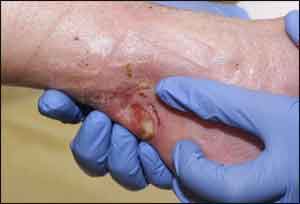- Home
- Editorial
- News
- Practice Guidelines
- Anesthesiology Guidelines
- Cancer Guidelines
- Cardiac Sciences Guidelines
- Critical Care Guidelines
- Dentistry Guidelines
- Dermatology Guidelines
- Diabetes and Endo Guidelines
- Diagnostics Guidelines
- ENT Guidelines
- Featured Practice Guidelines
- Gastroenterology Guidelines
- Geriatrics Guidelines
- Medicine Guidelines
- Nephrology Guidelines
- Neurosciences Guidelines
- Obs and Gynae Guidelines
- Ophthalmology Guidelines
- Orthopaedics Guidelines
- Paediatrics Guidelines
- Psychiatry Guidelines
- Pulmonology Guidelines
- Radiology Guidelines
- Surgery Guidelines
- Urology Guidelines
More effective treatment of diabetic wounds in sight

Thrombospondin-2 (TSP2), a specific protein which is elevated in wounds of the diabetic patients and is required for their maintenance, could be a target for a specific therapy for diabetic wounds by reversal of its effects, suggests a study. The research conducted by Britta Kunkemoeller, a doctoral student at Yale University, will be presented at the annual meeting of American Society for Investigative Pathology during the 2018 Experimental Biology meeting.
This research holds importance in the current scenario, whereby nearly 62 million Indians, more than 7 percent of the population, are afflicted by diabetes. Development of diabetic wounds is one of the most debilitating and frustrating complications of diabetes which can persist for months.
Treatment for these wounds is mostly limited to standard wound care, such as moist bandages, removal of damaged tissue and footwear that reduces pressure on the wound. Despite these measures, the wounds often persist. In the most severe cases, it becomes necessary to amputate the affected foot or lower leg; diabetic wounds are the leading cause of amputations in the United States.
"To determine whether TSP2 contributes to delayed wound healing, we genetically removed TSP2 from a mouse model of diabetes and observed improved wound healing. Our study shows that TSP2 could be a target for a specific therapy for diabetic wounds," said Kunkemoeller.
Treatment for these wounds is mostly limited to standard wound care, such as moist bandages, removal of damaged tissue and footwear that reduces pressure on the wound. Despite these measures, the wounds often persist. In the most severe cases, it becomes necessary to amputate the affected foot or lower leg; diabetic wounds are the leading cause of amputations in the United States.
Most previous work on wound healing in diabetes has focused on the types of cells that are involved in wound healing such as immune cells, skin cells and the cells that form blood vessels. By contrast, Kunkemoeller's research focuses on TSP2, a component of the extracellular matrix. The extracellular matrix is a meshwork that serves as the structural foundation for cells, like the scaffolding used in construction.
In addition to providing structural support, the extracellular matrix regulates processes that are important to wound healing, including the behavior of immune, skin and vessel-forming cells. TSP2 is a component of the extracellular matrix that influences how the matrix is formed, as well as the development and communication of other types of cells that grow within the matrix.
"Our focus on TSP2, therefore, allowed us to study a single molecule that influences several wound-healing related processes," explained Kunkemoeller.
The team bred mice that develop type 2 diabetes but cannot produce TSP2. When the researchers induced wounds in these mice, they found that the mice without TSP2 healed significantly better and faster than other mice that had diabetes along with normal levels of TSP2.
They also analyzed the factors that influence how much TSP2 the body produces. That part of the study revealed that TSP2 production increases when blood sugar levels are higher, explaining why people with diabetes have higher levels of TSP2 than people without diabetes.
"Currently, our lab is developing engineered biomaterials derived from extracellular matrix that lacks TSP2," said Kunkemoeller. "Our plan is to apply such materials to diabetic wounds in mouse models in order to evaluate their efficacy. Going forward, additional research will focus on either preventing the production or inhibiting the function of TSP2 in diabetic wounds."

Disclaimer: This site is primarily intended for healthcare professionals. Any content/information on this website does not replace the advice of medical and/or health professionals and should not be construed as medical/diagnostic advice/endorsement or prescription. Use of this site is subject to our terms of use, privacy policy, advertisement policy. © 2020 Minerva Medical Treatment Pvt Ltd